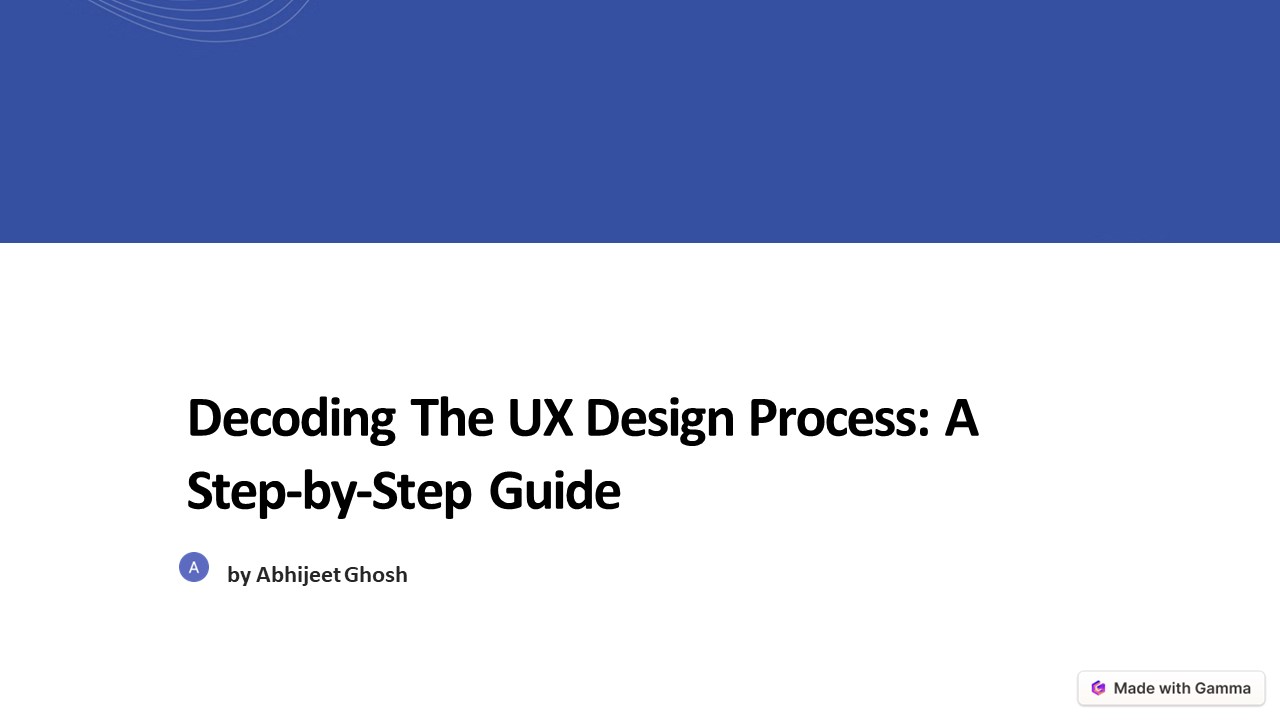Decoding the UX Design process - A step-by-step guide - PowerPoint PPT Presentation
Title:
Decoding the UX Design process - A step-by-step guide
Description:
Dive deep into the world of UX design process with this comprehensive guide, exploring every facet of the process to create meaningful and user-centric digital experiences. – PowerPoint PPT presentation
Number of Views:2
Title: Decoding the UX Design process - A step-by-step guide
1
Decoding The UX Design Process A Step-by-Step
Guide
by Abhijeet Ghosh
2
Understanding the User Experience (UX) Design
Process
Understanding the User Experience (UX) design
process is essential to developing products that
appeal to users in the dynamic world of digital
experiences. To break down the complex phases in
the UX design process, this post offers useful
information to both organizations and designers.
3
Understanding the Foundation What is UX Design?
Before delving into the step-by-step guide for
the UX Design Process, lets establish a solid
foundation by understanding what UX design is.
User Experience design is the art and science of
crafting products that not only meet users needs
but also deliver a delightful and intuitive
experience. It encompasses a holistic approach,
combining user research, information
architecture, interaction design, and visual
design.
4
The Essence of the UX Design Process
1
2
3
Research and Discovery
Defining Goals and Objectives
Information Architecture
- Thorough analysis of the target audiences
requirements.
- Establishing precise goals and objectives after
obtaining research insights.
- Creating a smooth and understandable framework
for the product.
- Includes competitive analysis, user interviews,
and surveys.
- Ensures alignment with corporate objectives and
user expectations.
- Use of sitemaps and wireframes to outline the
user interfaces basic structure.
- Designers provide the foundation for a
user-centric design.
4
5
6
Prototyping
User Testing
Visual Design
- Development of interactive prototypes after
information architecture.
- Assessment of how actual consumers interact with
the prototype.
- Adding aesthetics to the design, including color
schemes, typography, and imagery.
- Stakeholders can visualize how the product works
and flows.
- Usability testing to find issues and adjust the
design for user satisfaction.
- Transformation of wireframes into visually
appealing interfaces.
- Provides important feedback and iteration.
7
8
Development and Implementation
Monitoring and Iteration
- Collaboration between developers and designers to
bring the design to life.
- Continuous improvement through analytics tools
tracking user behavior.
- Constant communication to ensure the finished
output matches the desired user experience.
- Iterative upgrades and improvements based on user
feedback.
5
Key Takeaways Navigating the UX Design Landscape
In decoding the UX design process, several key
takeaways emerge
1
2
3
User-Centric Approach
Iterative Nature
Collaboration is Key
The process is not linear but iterative, with
each phase influencing and refining the others.
Successful UX design requires seamless
collaboration between designers, developers, and
stakeholders.
At its core, UX design revolves around
understanding and prioritizing user needs and
preferences.
4
Continuous Improvement
The UX design process doesnt end with a product
launch it involves continuous monitoring and
improvement based on user feedback.
6
Conclusion
A methodical and deliberate strategy for
developing digital goods that enthrall and engage
people can be found by deciphering the UX design
process. Designers and companies may successfully
negotiate the complexity of UX design by using
this step-by-step method, which guarantees the
creation of products that not only meet but also
go beyond user expectations. Delivering
significant and unforgettable experiences in the
digital sphere is the goal of fully embracing the
spirit of user-centric design.































